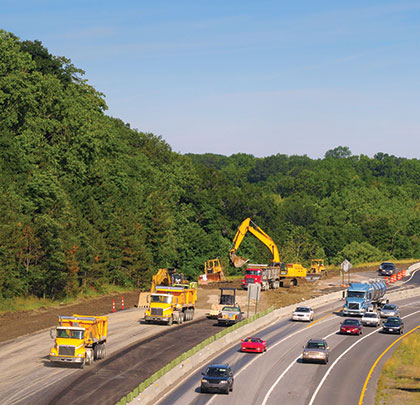State Departments of Transportation (DOTs) are spending a lot of time discussing safety. They generate marketing materials, create billboards, and launch compelling advertising campaigns. They employ safety officers and establish safety departments. Yet, when it comes to protecting workers in the work zones, instead of spending the money to acquire safety equipment and crashworthy devices, State DOTs often respond that they don’t want to pay extra for safety. They claim that what they are doing is working. They assert that it’s the contractors’ responsibility. But lives are at risk. Simply paying lip service to safety, without more, has never worked.
According to the 2014 AGC study, more than 45 percent of contractors surveyed had vehicles crash into their work zones in the past year. Of these work zone accidents, 43 percent involved motor vehicle operators or passengers that were injured, and 16 percent resulted in fatalities of the drivers and occupants of the vehicles.
WHAT ARE THE ISSUES
It is widely known that there are problems. The real tension lies between paying for positive protection in the work zones versus the cost of losing lives because the job was not done safely. State DOTs tend to blame drivers who are traveling through the work zone areas for being distracted, but educating motorists is not the only answer.
More than 10 years ago, former FHWA deputy executive director Vincent F. Schimmoller testified that “We must design ‘defensive’ work zones. We need to find new ways to better balance the need for traveler mobility through work zones, and the space, lighting, and environment that is needed to get the job done safely.” Schimmoller further explained that “It is difficult to change driver behavior in a work zone. Barrier separation between motorists and workers, increased use of truck-mounted attenuators, and intrusion alarms for the worksite could contribute to an improvement in safety for motorist and worker. These practices cost money, but save lives.” (July 24, 2001, Schimmoller testimony during Congressional hearing on Work Zone Safety.)
WORK ZONE PROTECTION
State DOT engineers clearly know the danger inherent in not having positive protection in a work zone. While standing behind a 28-inch fluorescent-orange traffic cone made of flow-molded PVC may catch a driver’s attention, it provides absolutely no protection against the impact of a vehicle that has intruded into the work zone. If the State DOTs refuse to include appropriate safety equipment and crashworthy devices in their contract specifications, and then further fail to provide such equipment and devices to the contractors or reimburse them for it, work zones will continue to be unsafe.
By definition, temporary work zones may be the most dangerous. The public is not familiar with driving through them, and greatly disparate speed and congestion are known to contribute to delays and accidents, which inevitably spill over into the work zones.
In the April 2014 highway work zone study conducted by the Associated General Contractors of America, 45 percent of highway contractors responded that they had motor vehicles crash into their construction zones during the past year. More than 20 percent of work zone crashes injure construction workers and 6 percent of those crashes kill them. Based on these statistics, the study found that work zone crashes killed an even greater percentage of vehicle drivers and passengers.
VALUE OF LIFE
In recent years there has been an increase in the number of lawsuits filed by the families of the deceased, and by the injured workers or motorists, against the State DOTs and their contractors for wrongful death and negligence. Contractors and their insurance carriers should be asking the State DOTs why they did not authorize or include specifications for positive protection and crashworthy devices in work zones. With the innovative crashworthy devices that are now available to save lives, liability should be assessed against those State DOTs that only talk about safety—and refuse to spend the necessary funds to make it happen.
The U.S. DOT recently issued guidance that established the value of a life for DOT analyses to be $9.1 million in the base year 2012. With such high financial risks, there is no reason for State DOTs to refuse to pay for positive protection that will stop the fatalities and injuries from occurring in the work zones. Previously, there might not have been options for work zone protection other than orange cones and attempts at “traffic control,” but now there are.
SOLUTIONS EXIST
As explained by Scott Schneider in his article, Work Zone Intrusions Threaten Safety, “Barrels or cones will not keep speeding motorists out of work zones.” Schneider identified eight options that will assist in guarding against vehicle intrusions into a work zone, including new mobile barriers, vehicle arresting systems, temporary rumble strips, automated flagging devices, better signage, other effective means, such as rolling road blocks and use of law enforcement, speed management, and intrusion alarms.
Driver mistakes are inevitable. Motorists at times will be confused, distracted, or become involved in an accident. Responsible contractors strive to protect their workers and States need to enable them to do so.
For More Information: What can you do? Ask your insurance carrier to send a letter to applicable State DOT Directors and Commissioners asking them to include positive protection in their specifications.
_________________________________________________________________________
Modern Contractor Solutions, May 2015
Did you enjoy this article?
Subscribe to the FREE Digital Edition of Modern Contractor Solutions magazine.

High Stakes


